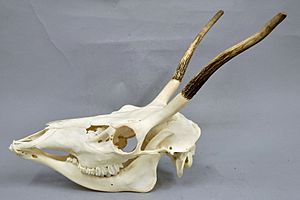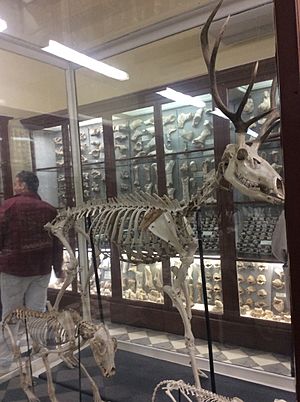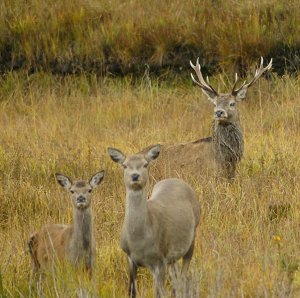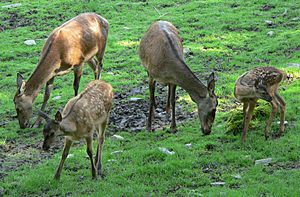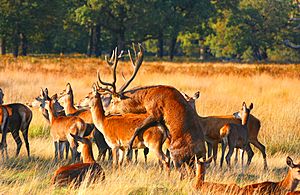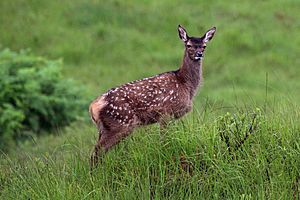Red deer facts for kids
Quick facts for kids Red deer |
|
|---|---|
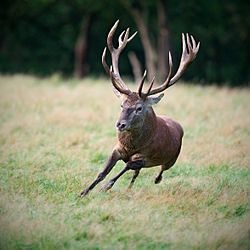 |
|
| Male (stag) | |
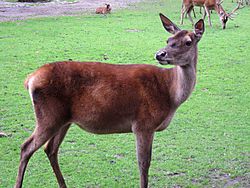 |
|
| Female (hind) | |
| Conservation status | |
| Scientific classification | |
| Kingdom: | |
| Class: | |
| Order: | |
| Suborder: | |
| Family: | |
| Subfamily: |
Cervinae
|
| Genus: |
Cervus
|
| Binomial name | |
| Cervus elaphus Linnaeus, 1758
|
|
 |
|
| Range of Cervus elaphus | |
The red deer, Cervus elaphus, is one of the largest deer species in the world. These amazing animals live across much of Europe, the Caucasus Mountains, Asia Minor, and parts of western and central Asia. You can also find them in the Atlas Mountains of northwestern Africa, where they are the only deer species.
Red deer have also been brought to new places like Australia, New Zealand, and Argentina. In many parts of the world, their meat, called venison, is a popular food source.
Contents
What Red Deer Look Like
The red deer is the fourth-largest deer species. Only moose, elk, and sambar deer are bigger. Red deer are ruminants. This means they chew their food twice, like camels, goats, and cattle. They also have an even number of toes on each hoof.
European red deer have a longer tail than their relatives in Asia and North America. Red deer from different places can look a bit different. They vary in size and antler shape. The smallest red deer is the Corsican red deer, found on the islands of Corsica and Sardinia. The largest is the Caspian red deer, which lives in Asia Minor and the Caucasus.
Red deer in central and western Europe also vary in size. Some of the biggest are found in the Carpathian Mountains. Red deer that were brought to New Zealand and Argentina have also grown very large.
Male red deer are called stags, and females are called hinds. Hinds are much smaller than stags.
A male red deer is usually about 175 to 250 cm (69 to 98 in) long. He can weigh between 160 to 240 kg (350 to 530 lb). A female is about 160 to 210 cm (63 to 83 in) long. She weighs about 120 to 170 kg (260 to 370 lb). Their tail adds another 12 to 19 cm (4.7 to 7.5 in). They stand about 95 to 130 cm (37 to 51 in) tall at the shoulder.
The largest red deer, from the Carpathian Mountains, can weigh up to 500 kg (1,100 lb). The smallest, the Corsican red deer, weighs about 80 to 100 kg (180 to 220 lb).
In summer, European red deer have reddish-brown coats. Many male deer grow a short mane of hair on their neck in autumn. This mane is thickest on stags from the British Isles and Norway. Female deer do not have neck manes.
Antlers: Stags' Crowns
Only male red deer (stags) grow antlers. Antlers start growing in spring and fall off each year, usually in late winter. They are made of bone and can grow very fast, up to 2.5 cm (1 in) a day!
When antlers are growing, they are covered in a soft, fuzzy skin called velvet. This velvet protects the new antlers. European red deer antlers are usually straight and rough. Larger males often have a "crown" or "cup" shape at the top.
Antlers are linked to a stag's testosterone levels. As testosterone drops in autumn, the velvet comes off, and the antlers stop growing. Then, as autumn continues, the antlers become hard. The stags' testosterone levels rise for the mating season, called the rut.
Seasonal Coats
In autumn, all red deer grow thicker coats. This helps them stay warm in winter. Their winter coats are often grey or lighter in color. The Caspian red deer has a grey winter coat with a clear light patch on its rump. Western European red deer have a greyish-brown coat with a darker yellowish rump patch.
By summer, the heavy winter coat is shed. Deer rub against trees to help remove the old hair. Their summer coats are usually more reddish and darker. Some European red deer may even have a few spots on their backs in summer.
Where Red Deer Live
The ancestors of red deer first appeared in Eurasia about 12 million years ago.
Europe and North Africa
European red deer are found in southwestern Asia, North Africa, and Europe. In Ireland, the red deer is the largest wild land mammal. The Barbary stag is the only deer species in Africa. It lives mainly in the Atlas Mountains in Morocco, Tunisia, and Algeria.
In the Netherlands, a large group of about 3,000 red deer lives in the Oostvaarders Plassen nature reserve. In France, the red deer population has grown a lot, from 30,000 in 1970 to about 160,000 in 2014. They have even moved into higher mountain forests.
In the United Kingdom, red deer live in Scotland, the Lake District, and the South West of England. Some of these groups have mixed with sika deer. Other groups started from deer that escaped from farms or were released. Red deer numbers are growing in England and Wales.
New Zealand
Red deer were brought to New Zealand by groups that wanted to introduce new animals. The first red deer arrived in 1851 from England. More deer were released until 1914. Between 1851 and 1926, over 800 red deer were released in 220 different places.
Red deer have done very well in New Zealand. They are widely hunted there. Some of them have even mixed with American elk. New Zealand red deer grow very large antlers, which hunters love. However, they are also seen as a pest and are often culled by professional hunters using helicopters.
Australia
The first red deer came to Australia in 1860 from England. More were brought to New South Wales, Queensland, South Australia, and Western Australia. Today, red deer numbers are increasing across Australia. Many new groups come from deer that escaped from farms.
Argentina and Chile
In Argentina and Chile, red deer have caused problems for native animals, like the South Andean deer. The International Union for Conservation of Nature calls the red deer one of the world's 100 worst invasive species in these areas.
Seasonal Travel
Red deer in Europe often move to lower, more wooded areas for winter. In summer, they travel to higher places where there is more food. This is also where they have their calves.
Red Deer Families
Adult red deer usually live in groups of only males or only females for most of the year. During the mating season, called the rut, male stags compete for the attention of the hinds. They try to keep a group of hinds together.
Rival stags challenge each other by roaring loudly and walking side-by-side. This helps them check out each other's antlers and size. If neither stag gives up, they might fight with their antlers. Sometimes, stags can get serious injuries.
Dominant stags follow groups of hinds during the rut, from August into early winter. A stag might have up to 20 hinds in his group. Only older, strong stags can keep a group of hinds. Stags that are two to four years old, or over 11 years old, usually stay on the edges of larger groups. Stags that hold a group of hinds rarely eat and can lose a lot of weight.
Male European red deer have a special roar during the rut. This roar helps them in their forest homes. They roar to keep their group of females together. Females are first attracted to males who roar most often and loudest. Males also roar when competing with other males. Roaring is most common in the early morning and late evening. This is when red deer are most active.
Life Cycle and Reproduction
Female red deer can start having babies when they are 2 years old. They usually have one calf each year, but sometimes two. A female is pregnant for about 240 to 262 days. When born, a calf weighs about 15 kg (33 lb).
All red deer calves are born with spots, like many other deer. They lose their spots by the end of summer. However, some adult red deer might keep a few spots on their backs. Calves stay with their mothers for almost a full year. They leave when the next calves are born.
Red deer can live for over 20 years in zoos. In the wild, they usually live 10 to 13 years. Some groups that have fewer predators can live up to 15 years.
Taxonomy
For a long time, scientists thought red deer and elk (or wapiti) were the same species. But now, genetic tests show they are two different species.
The common red deer is also known simply as red deer.
| Name | Subspecies | Status | Historical range | Notes |
|---|---|---|---|---|
Central European or common red deer |
C. e. hippelaphus | Western and Central Europe, Balkans | Medium to large deer, with the biggest found in the Carpathian Mountains. They are light-colored with a light rump patch. | |
Maral or Caspian red deer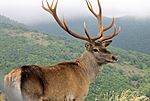 |
C. e. maral | Asia Minor, Crimea, Caucasus Region and northwestern Iran | Large deer with a dark grey coat, which turns dark brown in summer. | |
Norwegian red deer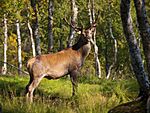 |
C. e. atlanticus | Norway | A small type of red deer. | |
Scottish red deer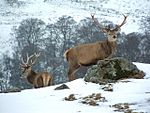 |
C. e. scoticus | Scotland and England | Slightly smaller than other red deer in Western Europe. Its coat is lighter. | |
Iberian red deer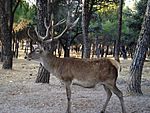 |
C. e. hispanicus | Iberian Peninsula | Smaller and more greyish than the common red deer. | |
Corsican red deer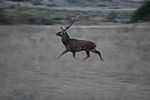 |
C. e. corsicanus | Near Threatened (NT) | Corsica, Sardinia; probably introduced in historical times and identical with Barbary stag | One of the smallest red deer types. |
Bactrian deer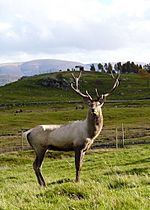 |
C. e. bactrianus | Vulnerable (D1) | Afghanistan, Kazakhstan, Kyrgyzstan, Turkmenistan, Uzbekistan and Tajikistan | Medium to large size with a greyish-white rump patch. Males do not have neck manes. |
| Yarkand deer | C. e. yarkandensis | Endangered (A1a) | Xinjiang | Similar to Bactrian deer, but with a light sandy coat. |
Barbary stag or Atlas deer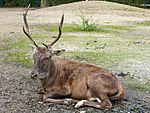 |
C. e. barbarus | Near Threatened | Algeria, Tunisia, and Morocco | One of the smallest red deer types. |
| Crimean deer |
C. e. brauneri | Near Threatened | Crimea | |
| Kashmir stag |
C. e. hanglu | Near Threatened | Kashmir valley |
Images for kids
-
Deer near Lake George Scott
-
Red deer tracks in the snow in Belgium.
-
A young stag in Great Glen in Scotland.
-
Velvet protects new antlers in spring. Glen Torridon, Scotland.
-
One male and three females in the Salburua wetlands of Basque Country, Spain.
-
A red deer in the Czech Republic.
See also
 In Spanish: Ciervo común para niños
In Spanish: Ciervo común para niños



